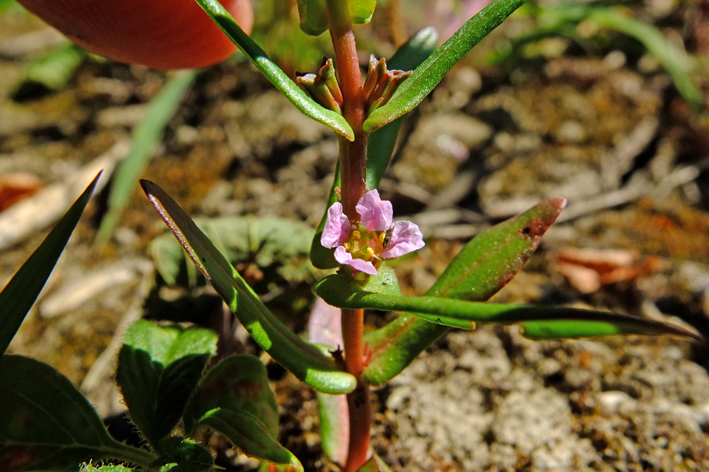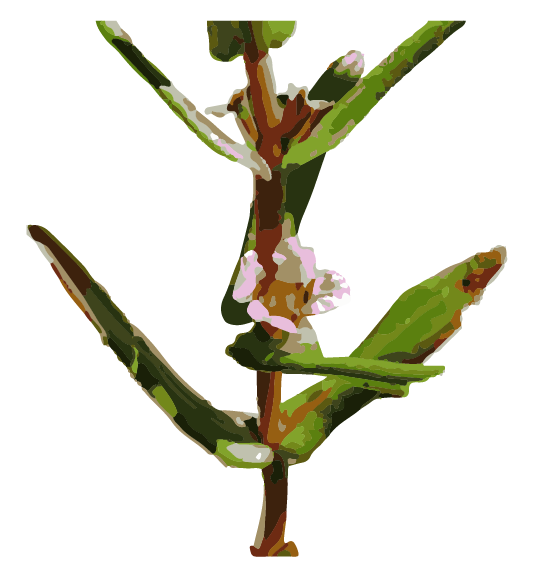Scarlet Ammannia

Species information
The following is a report on progress made towards the protection and recovery of Scarlet Ammannia (Ammannia robusta) in Ontario from 2007 to 2022, based on Ontario’s species-specific recovery policy. This report meets the legislative requirement for a review of progress under the Endangered Species Act, 2007 (ESA or “the Act”). Scarlet Ammannia is listed as endangered on the Species at Risk in Ontario (SARO) List under the ESA.
Scarlet Ammannia has been classified as a species at risk since 2004. It was originally classified as an endangered – not regulated species and was subsequently re-classified and listed as endangered under the ESA when it came into force in June 2008.
Scarlet Ammannia has been protected from being killed, harmed, harassed, captured or taken since 2008.
In addition, the habitat of Scarlet Ammannia has been protected from being damaged or destroyed since 2013.
The species-specific recovery policy for Scarlet Ammannia, known as the Government Response Statement (GRS) was published in 2018 and includes the government’s recovery goal for the species and the actions and priorities it intends to lead or support to help achieve that goal. The GRS considers science advice provided in the recovery strategy (published in 2017), such as species biology, habitat needs, threats to survival, knowledge gaps and approaches to recovery, when developing recovery actions for the species. As legislated in the Act, the purpose of this Review is to report on progress made towards implementing the protection and recovery actions in the GRS. The review can also help identify opportunities to adjust and adapt the implementation of protection and recovery actions to achieve the recovery goal for the species.
Further information about Scarlet Ammannia, including the threats that it faces, and actions being taken to help protect and recover this species is available on the Government of Ontario webpage for Scarlet Ammannia. A summary on the progress towards the protection and recovery of Scarlet Ammannia and an annual update on the broader species at risk program (i.e. the Introduction to the 2023 Review of Progress report) is available on the Review of Progress towards the Protection and Recovery of Ontario’s Species at Risk webpage.
Snapshot: Progress towards the protection and recovery of Scarlet Ammannia
Progress towards meeting the recovery goal
- The recovery goal in the Government Response Statement (GRS) for Scarlet Ammannia in Ontario is to “maintain the distribution of the species at locations where it occurs in Ontario, and where feasible, enable natural increases in abundance by reducing threats to the species and its habitat. The government supports investigating the feasibility of augmenting populations located on conservation lands, where suitable habitat is available.”
- Progress has been made towards implementing the majority of the government-led actions. Initial progress has been made towards implementing all of the government-supported recovery objectives and five of the associated actions. Examples of progress include:
- Conducting targeted surveys for Scarlet Ammannia during low water years where populations occur and in areas where it has been reported or predicted to occur
- Conducting studies to better understand the habitat conditions required by Scarlet Ammannia
- Conducting research on Scarlet Ammannia biology, including seed ecology such as dispersal mechanisms and germination requirements
- In alignment with the GRS, further work is required to:
- Work collaboratively with land owners, land managers and municipalities to develop, implement and evaluate habitat management plans to improve habitat conditions for the species. Plans may include practices such as enabling suitable natural or artificial water level fluctuations to occur in the species’ habitat
- Encourage land owners and land managers to identify and implement approaches to reduce the impacts of shoreline development, recreational activities and other land uses (e.g., agriculture) on Scarlet Ammannia and its habitat
- Conduct studies to better understand methods to improve habitat conditions, including developing and evaluating methods to improve habitat conditions such as restoring suitable hydrological disturbances (natural or artificial), removal of competing or invasive plants, or modifying agricultural practices to be compatible with Scarlet Ammannia persistence
Occurrences and distribution:
- Nine populations of Scarlet Ammannia have been documented in Ontario, all in Essex County. Currently, eight of these populations are extant, whereas the remaining one satisfies conditions to be considered historical. Since 2008, the presence of Scarlet Ammannia was reconfirmed at two locations after 12 and 16 years, respectively, as a result of seed bank studies. Four populations of Scarlet Ammannia have been newly identified since 2008.
- The Natural Heritage Information Centre (NHIC) has received 47 records of the species based on observations made between 1974 and 2022.
Government-supported stewardship projects:
- Through the Species at Risk Stewardship Program, the Government of Ontario has enabled its stewardship partners to conduct 10 projects (by providing $464,069 in funding) that have supported the protection and recovery of multiple species, including Scarlet Ammannia. Five projects ($307,110) focused on multiple species at risk, including Scarlet Ammannia (e.g., landscape-level habitat restoration projects, outreach and education focussing on a certain group of species such as those present in a region), while the other five projects ($156,959) focused exclusively on Scarlet Ammannia.
- The government’s support helped its stewardship partners to involve 161 individuals who volunteered 7,847 hours of their time towards protection and recovery activities for species at risk, including Scarlet Ammannia. The estimated value of these voluntary contributions, as well as additional funding and in-kind support, is $404,259.
- Stewardship partners reported that through their actions 188.8 hectares of habitat were enhanced for Scarlet Ammannia and other species at risk that inhabit the same ecosystems.
- Stewardship partners reported providing outreach on multiple species at risk, including Scarlet Ammannia, to 26,114 individuals.
Supporting human activities while ensuring appropriate support for species recovery:
- The Government of Ontario has issued three permits for this species: all three were ‘protection or recovery’ permits issued under clause 17(2)(b) of the ESA.
- One agreement was entered into for Scarlet Ammannia. This agreement was enabled through Ontario Regulation 242/08 (prior to the July 1, 2013 amendment).
- Seven activities have been registered for the species. The activities were registered under ‘species protection, recovery activities’ (section 23.17) and ‘threats to health and safety, not imminent’(section 23.18) under Ontario Regulation 242/08 of the ESA.
Reporting on the progress towards the protection and recovery of Scarlet Ammannia
Recovery Goal
The government’s goal for the recovery of Scarlet Ammannia is to maintain the distribution of the species at locations where it occurs in Ontario, and where feasible, enable natural increases in abundance by reducing threats to the species and its habitat. The government supports investigating the feasibility of augmenting populations located on conservation lands, where suitable habitat is available.
The implementation of government-led and government-supported actions demonstrates progress towards reaching the desired objectives and the recovery goal set out in the GRS.
Progress towards implementing government-led actions
Progress has been made towards implementing the majority of government-led actions identified in the GRS. Common actions for the government to lead as it works towards achieving a species’ recovery goal include:
- Educate other agencies and authorities involved in planning and environmental assessment processes on the protection requirements under the ESA.
- Encourage the submission of Scarlet Ammannia data to the Ministry of Natural Resources and Forestry’s (MNRF) central repository at the Natural Heritage Information Centre.
- Undertake communications and outreach to increase public awareness of species at risk in Ontario.
- Continue to monitor the Scarlet Ammannia populations and their habitat in provincial protected areas.
- Continue to protect Scarlet Ammannia and its habitat through the ESA.
- Support conservation, agency, municipal and industry partners, and Indigenous communities and organizations to undertake activities to protect and recover Scarlet Ammannia. Support will be provided where appropriate through funding, agreements, permits (including conditions) and/or advisory services.
- Encourage collaboration, and establish and communicate annual priority actions for government support, in order to reduce duplication of efforts.
- Continue to implement the Ontario Invasive Species Strategic Plan to address the invasive species (e.g., Creeping Yellow Loosestrife (Lysimachia nummularia)) that threaten Scarlet Ammannia.
- Continue to implement Ontario’s Invasive Species Act to address the invasive species identified in regulation under the Act (e.g., European Common Reed, also known as Invasive Phragmites (Phragmites australis spp. australis) that threaten Scarlet Ammannia by restricting their importation, deposition, release, breeding/growing, buying, selling, leasing or trading.
- For populations that occur on Pelee Island:
- Explore opportunities to work collaboratively with the Township of Pelee, including the Pelee Island Environmental Advisory Committee, the federal government and local partners to develop an integrated (landscape/place-based) approach to managing species at risk with consideration of ecosystem values and sustainable resources on Pelee Island. This may include developing a strategic plan for species at risk and their habitats on Pelee Island
- Explore opportunities to work collaboratively with the Township of Pelee, including the Pelee Island Environmental Advisory Committee, the federal government and local partners to integrate approaches to stewardship and implementation of recovery activities
Specifically, a MNRF research biologist advised on a doctoral student thesis project that produced guidance for land managers controlling Invasive Phragmites located near Scarlet Ammannia. Guidance includes considering (1) wick applications
Key progress made towards implementing these actions is described in the following sections.
Ontario’s Invasive Species Act
The GRS for Scarlet Ammannia indicates that invasive species (e.g., European Common Reed, also known as Invasive Phragmites) pose a threat to the survival and recovery of the species in Ontario. The Ontario Invasive Species Strategic Plan, 2012 and the Invasive Species Act, 2015 provide the policy and legislative framework to prevent new invaders from arriving and surviving in Ontario, to slow and where possible reverse the spread of existing invasive species, and to reduce the harmful impacts of existing invasive species, including impacts on species at risk. This framework may support the implementation of actions to reduce the threats from invasive species.
For example, to prevent its further spread and introduction, Invasive Phragmites was listed as a restricted species under the Invasive Species Act in 2016. It is now illegal to import, deposit, release, breed/grow, buy, sell, lease or trade this restrictive invasive species in Ontario. It is also illegal to bring a restricted species into a provincial park or conservation reserve and to possess, transport, deposit or release them in these protected areas.
Occurrences and distribution
Nine populations of Scarlet Ammannia have been documented in Ontario. Eight are considered to be extant
Since 2008, four previously unknown populations of Scarlet Ammannia have been documented on Pelee Island, one of them after 2018. The presence of Scarlet Ammannia was reconfirmed at two mainland locations after 12 and 16 years, respectively, as a result of seed bank studies. At a third location, on Pelee Island, Scarlet Ammannia has been detected only in the seed bank. Seed bank studies have not been undertaken at the location of the historical population, where Scarlet Ammannia may persist.
The newly identified local populations are likely the result of increased search effort, use of alternative survey methods (i.e., soil core collection and seed bank assays) and greater education about Scarlet Ammannia and may not represent actual population increases, but rather increased knowledge about the distribution of the species.
It is possible that there are observations of Scarlet Ammannia that have not been submitted to the government. Encouraging the submission of observations of this species is included in the GRS as a government-led action. Submission of species observations increases our knowledge of where they occur and can play an important role in assessing the viability of species populations.
Everyone is encouraged, or may be required by an authorization or approval to submit observations of Scarlet Ammannia, and any other species at risk observed, to the NHIC for incorporation into the provincial record of observations.
-
47observations of this species were submitted to the NHIC since 2008.
Government-supported stewardship projects
An important government-led action in the GRS for Scarlet Ammannia is to support partners to undertake activities to protect and recover the species. Through the Species at Risk Stewardship Program the government has supported 10 projects ($464,069) designed to contribute to the protection and recovery of multiple species, including Scarlet Ammannia. Five of these projects ($307,110) were designed to provide benefits to multiple species at risk (e.g., landscape-level habitat restoration projects, outreach and education focussing on a certain group of species such as those present in a region), while five ($156,959) focused exclusively on Scarlet Ammannia.
In addition to the government funding, partners focusing exclusively on Scarlet Ammannia reported they were successful in securing additional funding ($77,911) from other sources, as did partners with projects designed to benefit multiple species at risk, including Scarlet Ammannia ($326,348). These amounts include in-kind support in the form of time and expertise provided by volunteers.
Stewardship partners reported that provincial funding helped them to secure in-kind support by involving one individual who volunteered 340 hours of their time towards protection and recovery activities that focused exclusively on Scarlet Ammania, which has an estimates value of $13,025. As well as 160 individuals who volunteered 7,507 hours of their time towards protection and recovery activities that focused on multiple species at risk, including Scarlet Ammannia, which has an estimated value of $227,373. Partners also reported that through both their efforts and the efforts of their volunteers to implement the GRS on Scarlet Ammannia, they were successful in enhancing 188.8 hectares of habitat that will benefit multiple species at risk, including Scarlet Ammannia. In addition, stewardship partners reported providing outreach on Scarlet Ammannia to 190 individuals, as well as ecosystem-based outreach on multiple species, including Scarlet Ammannia, to 25,924 individuals.
The remainder of this section highlights a project supported through the Species at Risk Stewardship Program as well as the corresponding government-supported recovery actions for the species.
A project undertaken by the Department of Biology at Wilfrid Laurier University from 2016 to 2019 advanced progress on government-supported actions to conduct targeted surveys for Scarlet Ammannia and to complete research to improve understanding of Scarlet Ammannia seed ecology and the habitat conditions required by the plant. Targeted surveys included vegetation transects and soil core collection for seed bank assays
-
 5
5projects including Scarlet Ammannia
-
 5
5projects for Scarlet Ammannia exclusively
-
 $307,110
$307,110for projects that included Scarlet Ammannia
-
 $156,959
$156,959projects for Scarlet Ammannia exclusively
-
 $404,259
$404,259in additional funding and in-kind support
-
 161
161volunteers
-
 7,847
7,847volunteer hours
-
 26,114
26,114people received outreach
-
 189
189hectares of habitat enhanced
Supporting human activities while ensuring appropriate support for species recovery
Supporting partners through authorizations and their associated conditions is an important government-led action.
Three permits have been issued for Scarlet Ammannia since the species has been protected under the ESA, all of which were ‘protection or recovery’ (17(2)(b)) permits. ‘Protection or recovery’ permits are issued if the purpose of the activity is to assist in the protection or recovery of a species at risk. The three permits were issued exclusively for Scarlet Ammannia. The permits were issued to authorize the project outlined in the preceding section.
One agreement was entered into for Scarlet Ammannia. This agreement was enabled through Ontario Regulation 242/08 (prior to the July 1, 2013 amendment). Conditions of the agreement involve implementing actions in the mitigation plan, including, but not limited to:
- Constructing a new area of habitat for Scarlet Ammannia on lands owned and managed by the Nature Conservancy of Canada
- Removing the upper layer of soil from the area to be impacted by the authorized activity, where Scarlet Ammannia has been observed, and depositing it where new habitat has been constructed
- Documenting how the preceding actions were completed and providing the documentation to the Ministry of the Environment, Conservation and Parks
Seven activities that may affect Scarlet Ammannia or its habitat have been registered for the purposes of Ontario Regulation 242/08: ‘General’ under the ESA. Six activities were registered under ‘threats to human health and safety, not imminent’ (section 23.18) and one was registered under ‘species protection, recovery activities’ (section 23.17). These registrations require the registrant to comply with all conditions of the regulation, such as:
- Giving the Ministry of the Environment, Conservation and Parks notice of the activity before it commences
- Having a mitigation plan prepared by a person with expertise on Scarlet Ammannia to facilitate avoidance or minimization of adverse effects on Scarlet Ammannia while the activity is carried out
- Taking reasonable steps to minimize adverse effects on Scarlet Ammannia while carrying out the activity
-
1agreements
-
7registrations
-
3protection and recovery permits
Progress towards implementing government-supported actions
Government-supported actions are organized under overarching recovery objectives. Progress has been made towards achieving all government-supported recovery objectives and implementing components of five of the associated actions identified in the GRS for Scarlet Ammannia.
Objective: Maintain or improve habitat suitability for Scarlet Ammannia populations and increase awareness of the species.
- Action No. 1 (High Priority) – Work collaboratively with land owners, land managers and municipalities to develop, implement and evaluate habitat management plans to improve habitat conditions for the species. Plans may include practices such as:
- enabling suitable natural or artificial water level fluctuations to occur in the species’ habitat, at appropriate times for the species, where feasible
- removing competing vegetation and invasive plants (e.g., Invasive Phragmites) posing a direct threat to Scarlet Ammannia, while ensuring that methods used do not adversely affect the species
- Action No. 3 – Promote awareness among land owners, land managers and land users about Scarlet Ammannia by sharing information on:
- how to identify the species
- the species’ habitat requirements
- protection afforded to the species and its habitat under the ESA
- actions that can be taken to avoid or minimize impacts to the species and its habitat
Under this objective, initial progress has been made towards advancing both actions.
Both actions have been advanced through projects supported by the Species at Risk Stewardship Program. Although management plans have not been developed to improve habitat conditions for Scarlet Ammannia, a project to control invasive plants in Small-mouthed Salamander habitat on Pelee Island included areas where Scarlet Ammannia occurs. Wilfrid Laurier University researchers distributed information about Scarlet Ammannia to land owners on Pelee Island to raise awareness and engage these land owners in their research project.
Objective: Increase knowledge of the distribution, abundance and habitat conditions of the species in Ontario.
- Action No. 4 (High Priority) – Work collaboratively with land owners, land managers and researchers to develop, implement and evaluate standardized survey and monitoring protocols, which take into account the varying ability to detect plants at different life stages, to:
- conduct targeted surveys for Scarlet Ammannia during low water years where populations occur and in areas where it has been reported or predicted to occur
- determine whether suitable habitat exists in areas that connect the habitat of known populations
- conduct regular monitoring of known populations to assess population trends, including abundance, extent, demographic variability (seed bank size versus mature plant abundance) and health. Compare data with habitat conditions and the presence and significance of threats to the species
Under this objective, initial progress has been made towards implementing one component of Action No. 4. Targeted surveys were conducted for Scarlet Ammannia at some of the locations where it has been reported to occur and a few where it was predicted to occur.
Progress on the implementation of Action No. 4 was supported by the Species at Risk Stewardship Program.
Objective: Increase knowledge of the habitat requirements and species’ biology of Scarlet Ammannia.
- Action No. 5 – Conduct studies to better understand the habitat conditions required by Scarlet Ammannia, and methods to improve habitat conditions, including:
- the location, water levels, timing and duration of flooding that occurs in the habitat of known populations
- the effect of within- and between-year water level fluctuation on Scarlet Ammannia during all life processes (e.g., germination, growth and flowering) and the relationship between water levels (e.g., location, level, timing and duration of flooding) and abundance at all sites
- the effects of competing and invasive vegetation on the habitat conditions required by Scarlet Ammannia
- the effects of agriculture practices on the habitat conditions required by Scarlet Ammannia
- developing and evaluating methods to improve habitat conditions, such as restoring suitable hydrological disturbances (natural or artificial), removal of competing vegetation or invasive plants, or modifying agricultural practices to be compatible with Scarlet Ammannia persistence
- Action No. 6 – Conduct research on Scarlet Ammannia biology, including studies of:
- population dynamics and viability
- seed ecology (e.g., dispersal mechanisms and distance, duration of viability, germination requirements)
- floral biology (e.g., pollination mechanisms)
- whether seed supply is a significant limiting factor for any populations
Under this objective, initial progress has been made towards implementing both actions. Most of the progress was made on increasing understanding of seed ecology and whether Scarlet Ammannia populations are limited by seed supply. A competition removal study was unsuccessful due to low seed germination success within the study plots.
Both actions were advanced through a project supported by the Species at Risk Stewardship Program.
Summary of progress towards meeting the recovery goal
The recovery goal for Scarlet Ammannia is “to maintain the distribution of the species at locations where it occurs in Ontario, and where feasible, enable natural increases in abundance by reducing threats to the species and its habitat. The government supports investigating the feasibility of augmenting populations located on conservation lands, where suitable habitat is available.” Effort made towards the government-led and government-supported actions may have helped to make progress towards this goal. For example, a Species at Risk Stewardship Program project to control European Common Reed in Lake Henry, at the north end of Pelee Island, may have reduced actual or potential impacts on the Scarlet Ammannia population at this location.
Recommendations
As stated in the GRS, this review of progress can be used to help identify whether adjustments to the implementation of GRS actions are needed, to achieve the protection and recovery of the species. Based on progress to date, the overall direction provided in the GRS for Scarlet Ammannia, particularly the implementation of actions identified as high priority and related research actions, should continue to guide protection and recovery of the species.
Although initial progress has been made towards the actions to conduct surveys and monitoring of Scarlet Ammannia populations and habitat, study Scarlet Ammannia seed ecology and the attributes of its habitat, understand the effects of competition from European Common Reed and of controlling European Common Reed with herbicides, and improve habitat conditions where Scarlet Ammannia occurs (including on agricultural land), further work is required to fully implement these and related actions.
While there has been much focus on the progression of other actions, the following actions require additional support to aid the protection and recovery of the species:
- Action No. 2 (High Priority) – Encourage land owners and land managers to identify and implement approaches to reduce the impacts of shoreline development, recreational activities and other land uses (e.g. agriculture) on Scarlet Ammannia and its habitat, including:
- undertaking site-specific land use best management practices to maintain or improve habitat conditions for the species
- installing signage to alert land users to the presence of the species and, where necessary and appropriate, installing physical barriers (e.g. fencing) to protect the species from trampling by humans, vehicles or livestock
- installing signage to alert boat operators to the presence of the species and the need to minimize boat wake and avoid dragging boats ashore
- Action No. 7 – Investigate the feasibility of augmenting populations of Scarlet Ammannia on conservation lands, where suitable habitat is available for the species.
As stated in the GRS, this review of progress can be used to help identify whether adjustments are needed to achieve the protection and recovery of the species. Based on progress to-date, the overall direction provided in the GRS for Scarlet Ammannia should continue to guide protection and recovery of the species, particularly those actions identified as high priority in the GRS.
Protecting and recovering Scarlet Ammannia will continue to be a shared responsibility that will require the involvement of many individuals, organizations and communities. Financial support for the implementation of actions may be available through the Species at Risk Stewardship Program. The government can also advise if any authorizations under the ESA or other legislation may be required to undertake a project. By working together, progress can continue to be made towards protecting and recovering Scarlet Ammannia in Ontario.
Footnotes
- footnote[1] Back to paragraph i.e., applications using a hand-held wick applicator, by means of which a wicking rope is saturated with herbicide poured into the applicator handle and then placed in direct contact with the target plant.
- footnote[2] Back to paragraph Underground horizontal stem.
- footnote[3] Back to paragraph A population is considered extant if it has been observed within the last 20 years or an appropriate interval for the species in question. Extant populations may have been extirpated, particularly if observations are not recent and updated information is unavailable.
- footnote[4] Back to paragraph A population is considered historical if it has been the object of several appropriate surveys and has not been detected within the last 20 years or an appropriate interval for the species. Alternatively, it is considered historical if it has not been the object of appropriate surveys and either is at a location where general habitat loss or degradation is known to have occurred or it has not been observed in 40 or more years. Historical populations may still exist, but updated information is unavailable.
- footnote[5] Back to paragraph An assay is a procedure whereby the contents of a soil core are added to seedling trays containing growth medium, seeds are germinated under controlled conditions and the seedlings are identified
- footnote[6] Back to paragraph These are effects on seed germination caused by the release of biochemicals in the soil.